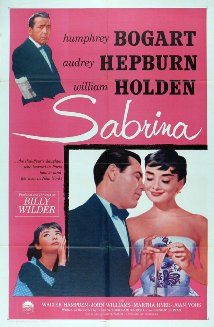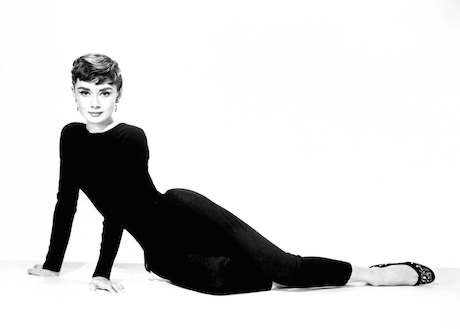We continue our 1954 celebration (Year of the Month) with abstew on Audrey...
 Audrey Hepburn isn't just a movie star, but a fashion icon. Her image is so closely linked to her style that the moments that immediately come to mind when we think of her - in a black cocktail dress, pearls, and oversized sunglasses nibbling a croissant in front of the window of Tiffany & Co, descending the stairs of the Louvre in a red evening gown, arms out-stretched with Winged Victory as backdrop to name just two - are all influenced by what she was wearing.
Audrey Hepburn isn't just a movie star, but a fashion icon. Her image is so closely linked to her style that the moments that immediately come to mind when we think of her - in a black cocktail dress, pearls, and oversized sunglasses nibbling a croissant in front of the window of Tiffany & Co, descending the stairs of the Louvre in a red evening gown, arms out-stretched with Winged Victory as backdrop to name just two - are all influenced by what she was wearing.
Every year some young ingénue is compared to Audrey on the red carpet. Her look and grace have become shorthand for a kind of elegance. In Jerry Maguire, when Renée Zellweger's Dorothy appears in a little black dress for her date with Tom Cruise's Jerry his adoring reaction is:
That's more than a dress. That's an Audrey Hepburn movie."
And it's thanks to the work of French designer Hubert de Givenchy and his creations on 1954's Sabrina that launched the timeless Audrey Hepburn look we know today. [More...]
But at the time of the film's release, the young designer's influence and involvement in the costumes for the film weren't even acknowledged. Edith Head had been working in the Paramount costume department since 1924. Thirty years later, she was one of the head costumers, overseeing a large staff of designers and tailors, but often receiving the sole production credit for the work. She had previously worked with Audrey the year before on Roman Holiday (Audrey's Hollywood debut). The film won Audrey a Best Actress Oscar and Head received her 5th Oscar win in the relatively new Best Costume Design category. But for their second film together, the story of a chauffer's daughter that goes to school in Paris to return a stylish fashionista, it was Audrey herself that persuaded director Billy Wilder to allow her to use an actual Parisian couturier to supply the clothes for the girl's transformation. And just as Sabrina in the film emerges a new woman after her trip to Paris, after meeting Givenchy in the City of Lights, Audrey would also never be the same.

Originally intended to meet with Cristóbal Balenciaga, but not wanting to disturb the master in the middle of creating a collection, Audrey met with one of his protégés who happened to be working on his own presentation, only the fourth in his career as a solo designer. Givenchy expressed that he was surprised to find the "Miss Hepburn" that came to see him in his studio that day was not actually the actress he had imagined. In the summer of 1953, Audrey was an unknown, as Roman Holiday would not be released until a few months later, and Katharine Hepburn had been an Oscar-winning star for two decades. Head would later accuse Audrey of purposely remaining elusive about her identity so that she could more easily gain an audience with the designer.
Givenchy initially turned down Audrey's offer to create her costumes for Sabrina as he was still hard at work at his own designs. But the actress insisted that there must be something he had already created that she could wear. So he showed her the model's clothes that had been exhibitied in his Spring/Summer 53 collection. She chose three designs that fit her perfectly and were brought back as part of Sabrina's chic new wardrobe.

The first was an Oxford-gray, calf-length travel suit that Sabrina wears along with a white pleated turban that had been created by Givenchy's own milliner for when she is newly arrived back in Long Island. Her new look is so different that David Larrabee (William Holden), the rich playboy of the home her father has worked in all her life, doesn't even recognize her as he drives her home from the train station. The double-breasted suit reeks of class and sophistication (no sweatpants for traveling here), but what makes it even more elegant is the way Audrey transforms her body language while wearing it. No longer the awkward girl in a ponytail that climbs trees to spy on David, she has truly transformed Sabrina into a refined woman.
 We next see Audrey's Sabrina in her Cinderella moment as she attends a party at the Larrabee's dressed in a gorgeous white organdy ball gown with black silk thread embroidery along the top of the bodice and the edge of the train. Edith Head had warned Audrey about choosing designs that were black and white as they didn't seem to photograph as well on camera. But the color scheme does well to allow Sabrina to stand out against the dresses of the other women and the simple design and lack of jewels make Audrey seem fresh and youthful against the stuffy looks of the other party patrons. This has to be my favorite look from this movie. I love how modern the dress appears with the ankle length in front, showing Audrey's smaller heels that resemble a dressier version of her signature ballet flats. But then how it's not afraid to have that dramatic train behind it to give a touch of refinement and, as Tim Gunn would say, a major wow factor. Humphrey Bogart even complained that in the scenes he has with Audrey in this dress all you can see is the back of his head as the camera lovingly takes in her perfection.
We next see Audrey's Sabrina in her Cinderella moment as she attends a party at the Larrabee's dressed in a gorgeous white organdy ball gown with black silk thread embroidery along the top of the bodice and the edge of the train. Edith Head had warned Audrey about choosing designs that were black and white as they didn't seem to photograph as well on camera. But the color scheme does well to allow Sabrina to stand out against the dresses of the other women and the simple design and lack of jewels make Audrey seem fresh and youthful against the stuffy looks of the other party patrons. This has to be my favorite look from this movie. I love how modern the dress appears with the ankle length in front, showing Audrey's smaller heels that resemble a dressier version of her signature ballet flats. But then how it's not afraid to have that dramatic train behind it to give a touch of refinement and, as Tim Gunn would say, a major wow factor. Humphrey Bogart even complained that in the scenes he has with Audrey in this dress all you can see is the back of his head as the camera lovingly takes in her perfection.
The final look that Audrey selected would go on to greatly influence the fashion of the day. It would also cause the most controversy regarding Edith Head and her claim to the film's fashions. For a dinner date with Bogart's Linus Larrabee, Sabrina dons a sleeveless black cocktail dress with bows at the shoulders. Audrey loved the dress's neckline as it hid her slender collarbone and accented her shoulders. The square cut had originally been known as a boat or bateau neckline, but after the success of the film became known as the "Sabrina" neckline and was much copied, becoming a popular look in the mid '50s. Until her death, Edith Head insisted that she was responsible for the dress's design and continued to take credit for it. Even drawing sketches to include in costume archives as proof. But the dress had already been shown in Givenchy's collection the year before. When Head was first hired to work at Paramount, she later admitted she got the job by passing off design sketches by other people as her own. It seemed that years later she wasn't above taking credit for other's work still.


Audrey brought Givenchy to attend a screening of the final film in Hollywood when they saw that the sole credit given for the costumes in the film was Edith Head as "Costume Supervision". The omission of the designer's name hurt even more when the film won Head another Oscar for Costume Design and she didn't even mention Givenchy in her speech. The win was surely based upon the costumes that Givenchy had supplied the movie, as the only outfit Head created for Audrey was a simple dress at the beginning of the film before she goes to Paris. Audrey insisted that whenever she used the designer's work again in a film that he would receive the acknowledgement he deserved. And for their next film collaboration, the 1957 musical Funny Face in which Audrey plays a fashion model, alongside Edith Head's name in the opening credits is Hubert de Givenchy as "Miss Hepburn's Paris Creations." He (along with Head) would also finally receive an Oscar nomination for his work on the film.
Givenchy would go on to design Audrey's costumes for Love in the Afternoon, her iconic looks in Breakfast at Tiffany's, Charade, Paris When It Sizzles, and How to Steal a Million. But more importantly Sabrina was the beginning of a life-long collaboration in which Audrey would become his muse and spokeswoman, wearing his designs in her real life and working with the designer to create the stylish legend that is Audrey Hepburn.
Still alive and in his 80s, Givenchy published a book of sketches this past November in honor of his friend titled To Audrey With Love. All these decades later, the love of Audrey, her style, and the effect that Givenchy himself had on her and the world of fashion remains hugely influential. Now if anyone could work on getting Edith Head's estate and the Academy to correct their oversight in regards to that Sabrina Oscar win, it would be much appreciated.

previous 1954 pieces
- Vintage Best ofs and Happenings
- The Best Actress Race via Life magazine covers
- Get Your Votes In on the Smackdown
